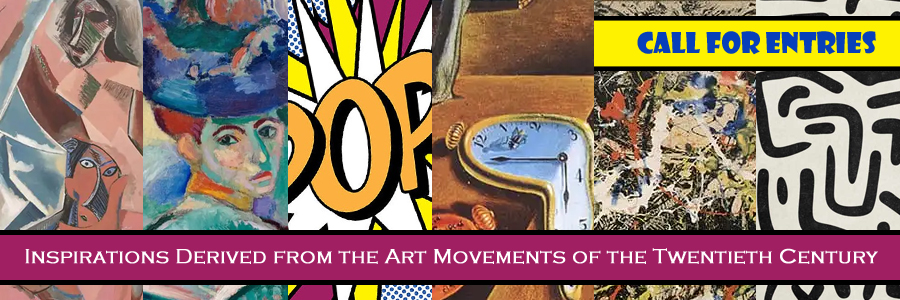
The 20th century welcomed a new era of artists who challenged the previous artistic movements. Beauty and aesthetics gave way to abstraction, expression and symbolism. From Pop Art to Fauvism, Post-Modernism to Cubism, and Expressionism to Dadaism, the twentieth century has an abundance of styles to inspire and challenge you!
ELIGIBILITY
- Open to any artist age 18 and up.
- Artists may submit 1-2 original works created in the last 2 years, which have not previously been exhibited at Blue Ridge Arts Center.
ENTRY FEE
- General Entry: $35.00 for 1-2 works
- BRAC Members: $30.00 for 1-2 works
- Students: $20.00 for1-2 works
Entry fee is non-refundable and due when entry is
submitted. Proceeds fund BRAC operating expenses.
MEDIA
Any 2D or 3D media is welcome.
2D Works:
- Work must be securely framed and wired.
- Gallery wrapped canvases may be unframed, if all edges are finished/painted.
3D Works:
- Must sit solidly or be mounted for hanging.
- Artwork must require no assembly.
- Jewelry must be presented in a shadow box.
EXHIBITION TIMELINE
REQUIRED: Complete Entry Paperwork Online By:
- Thursday, July 13 at 5:00pm
- Click here to submit online today!
Drop-off Artwork:
- Friday, July 14: 1:00-4:00pm
- Saturday, July 15: 10:00am-1:00pm
Exhibition on View:
- OPENING RECEPTION: July 21 (5:30-7:00 pm)
- July 21 through August 25, 2023
Wednesday-Friday: 1:00-4:00pm
Saturday: 10:00am-1:00pm
End of Show Pick-Up (no early pick-ups):
- Saturday, August 26: 10:00am-4:00pm
AWARDS
- Best in Show: $500
- 2nd Place: $250
- 3rd Place: $150
- Honorable Mention (2): $50
SALES
- Artists may offer their work for sale.
- BRAC will retain a 35% sales commission.
- Work must remain for the duration of the show. No early pick-ups.
Here are a few of the Twentieth Century Art Movements that may give you inspiration…
Cubism was one of the most influential movements of the 20th century. It was developed by Pablo Picasso and Georges Braque in the early 1900s. Cubism sought to break down traditional forms of art, such as perspective and modeling, and create new ways of representing reality.
Fauvism was another influential movement of the early 20th century. It was led by Henri Matisse and other artists who were known as the “Fauves,” or “wild beasts.” Fauvism was characterized by its use of bold, vibrant colors.
Expressionism was another important movement of the early 20th century. It emerged in Germany and Austria, and later spread to other parts of Europe. Expressionism was characterized by its use of intense, emotional colors and brushstrokes.
Dada was a movement that emerged in the aftermath of World War I. It was characterized by its rejection of traditional art forms and its focus on anti-art. Dada artists sought to shock and provoke with their work.
Surrealism was another important movement that emerged in the aftermath of World War I. It was characterized by its use of dreamlike imagery and its focus on the unconscious mind. Surrealist artists sought to create art that would evoke the irrational and the surreal.
Constructivism was a movement that emerged in Russia in the early 20th century. It was characterized by its use of geometric forms and its focus on industrial design. Constructivist artists sought to create a new visual language that would be suitable for the new Soviet Union.
Abstract Expressionism was the last major art movement of the 20th century. It emerged in the United States in the 1940s and 1950s. Abstract Expressionism was characterized by its use of abstract forms and its focus on the expression of the artist’s emotions.
Futurism was founded by poet Filippo Tommaso Marinetti in Milan in the early 20th century. Like its predecessors, Futurism emphasized abstraction and nontraditional representation. It valued speed, viscerality, youth and modernity and acted as a form of Italian liberation from its fraught history. Although founded in Italy, it’s influences also spread to other European countries.
Pop Art rose to prominence in the United States and United Kingdom during the 1950s and 1960s, taking inspiration from elements of mass media and popular culture. Pieces often featured juxtaposed or inconsistent elements from comic books, magazines and advertisements, placed together to emphasize the banality of popular culture. Often ironic or satirical, pop art aimed to subvert traditional ‘fine art.’
Minimalism emerged in New York in the 1960s in a continuation as the precedent diversion from traditional “high art.” Instead of luxury, beauty and expression, minimalism focused on brutal, geometric shapes, muted colors and anonymity. Most elements of biography or emotion were removed from minimalist art, drawing attention to the simplicity of the shape itself as the subject.
Photorealism is a style of visual art that is concerned with the technical ability to wow viewers. Primarily an American art movement, it gained momentum in the late 1960s and 1970s as a reaction against Abstract Expressionism. Here, artists were most concerned with painting and replicating a photograph to the best of their ability, carefully planning their work to great effect and eschewing the spontaneity that is the hallmark of Abstract Expressionism.
